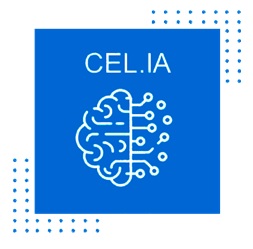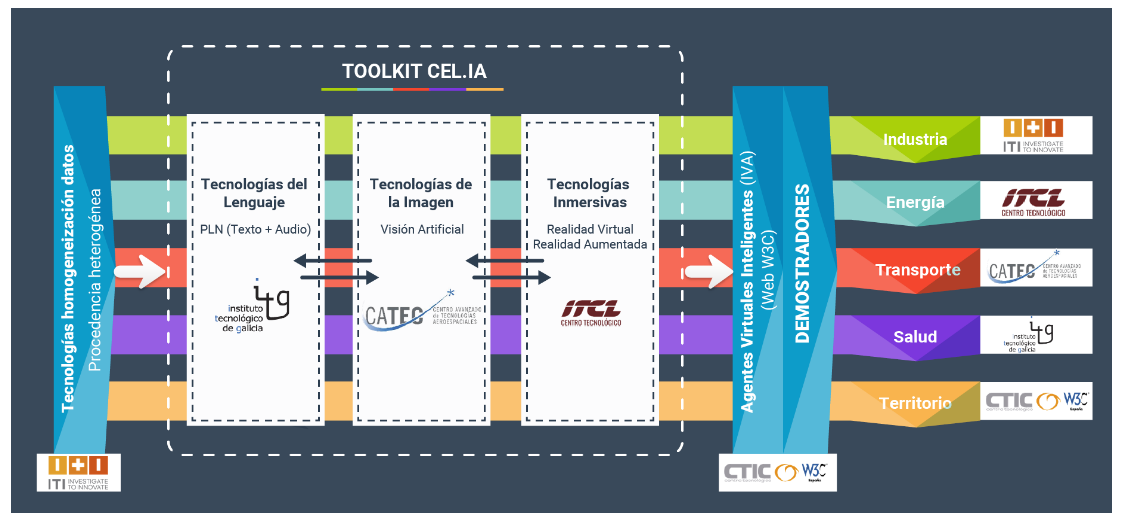"Consortium cErvera for Leadership in R&D&i in Applied Artificial Intelligence"
Project logo:

Funder:
Project (CER-20211022) recognized as a CERVERA Network of Excellence, funded by the Ministry of Science and Innovation through the Center for Industrial Technological Development (CDTI), charged to the General State Budgets 2021.

Partners
- 1 Technological Center for Information and Communication - CTIC
- 2 Galicia Institute of Technology - ITG
- 3 Castilla y León Technology Center - ITCL
- 4 Technological Institute of Informatics - ITI
- 5 Andalusian Foundation for Aerospace Development – Advanced Center for Aerospace Technologies – FADA-CATEC
Summary
CEL.AI is a key tool to reach the maximum capillarity and impact of Artificial Intelligence in the Spanish Economy and Society. The CEL.AI MISSION focuses on contributing to overcome the existing gaps and obstacles between end users (Company and Society) and Artificial Intelligence. The purpose is to help them to incorporate AI into their daily activities, by developing, transferring and applying solutions based on Cervera 21 Technologies (Virtual and Augmented Reality, Computer Vision and Natural Language Processing) in order to satisfy their needs.
In the course of the project, a Toolkit will be created, consisting of technological solutions for AI, resulting from the collaboration between the members of the Cluster.

The Toolkit will support five application demonstrators, which will be specified in the generation of Intelligent Virtual Agents on use cases for industry, energy, health, transport and smart territories. CATEC is involved in the cooperative development of the technologies described above for all demonstrators and is the leader of the transport demonstrator.
On the other hand, the CEL.AI strategic program is structured around 6 Objectives, covering all dimensions of cooperation:
1) CEL.AI COLLABORATION NETWORK – Development of the aforementioned Toolkit of technological solutions of Virtual and Augmented Reality, Computer Vision and Natural Language Processing, generated from a common technological roadmap built from the individual capabilities and competencies of each of the 5 Technology Centers.
CATEC coordinates the Work Line related to Imaging Technologies, which aims to analyse and develop a catalogue of activities associated with Computer Vision techniques to extend the expertise in the Artificial Intelligence for deep image processing. This means progress in the reconstruction and generation of 3D models, in the implementation of Deep Learning in embedded devices for AR, as well as in the recognition and categorisation of objects, defects and abnormalities in images. The application of more efficient algorithms (Green AI) in image processing will also be studied
CATEC also participates in the work lines related to Immersive Technologies, with the aim of exploring in depth Mixed Reality and its implementation in real time. The objective is to create tools for improving the field of telepresence and remote control of robotic systems through digital representations of the real world.
2) MOTIVATION OF CONTINUITY – To build a true and lasting network of collaboration between centres, where capacities, forces and efforts are joined in other structural areas, fundamental for the correct development of solutions: the technology monitoring and the identification of skills and competences, in order to achieve the real synergetic effect of the Cluster and ensure its sustainability over time.
3) COMMUNICATION AND ACTIVE LISTENING – To promote direct contact with Companies and Society, both for their understanding and awareness, and for the detection of their needs and limitations in order to have the permanent vision of the situation and problems of the end users (Company and Society).
4) MAXIMUM IMPACT AND CAPILLARITY – To achieve the maximum capillarity and impact of actions in companies, as well as in Society in general, with their corresponding economic and environmental derivatives.
5) AVAILABILITY OF TALENT – To address the great challenge of digital skills, internally in the Cluster itself, as well as in companies and society, attracting specialised talent to Technology Centers with motivating professional development plans and enabling both internal and external training programs for the promotion of scientific-technological vocations in young people, with special attention to gender factors.
6) REFERENCE ON THE INTERNATIONAL STAGE – Positioning of the Cluster on the European scene.
Contact person:
Eduardo Ferrera, Head of Automation and Robotics Unit.
Email: eferrera@catec.aero
Victor Alarcon, Senior Engineer of Unidad de Percepción e IA.
Email: vmalarcon@catec.aero


